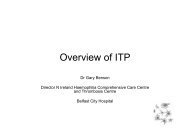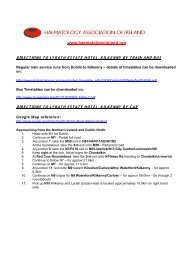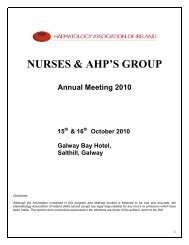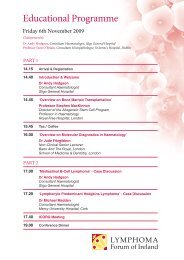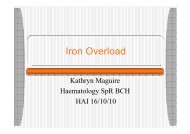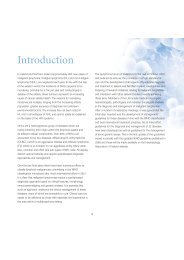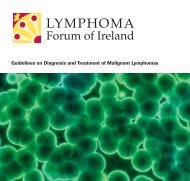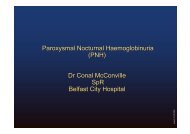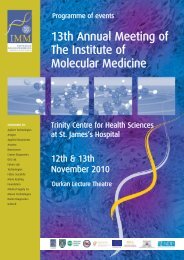Rory Wilkinson - Haematology Association of Ireland
Rory Wilkinson - Haematology Association of Ireland
Rory Wilkinson - Haematology Association of Ireland
You also want an ePaper? Increase the reach of your titles
YUMPU automatically turns print PDFs into web optimized ePapers that Google loves.
<strong>Rory</strong> <strong>Wilkinson</strong><br />
Clinical Nurse Specialist in Palliative Care<br />
R.P.N., R.G.N., Dip/Onc., B.N.S., HDip/PallCare,<br />
Certificate in Nurse Prescribing.
Other members <strong>of</strong> the team
<strong>Haematology</strong> & Palliative Care<br />
The aim <strong>of</strong> my presentation<br />
To create an awareness rather than a<br />
consensus <strong>of</strong> the role <strong>of</strong> Palliative<br />
Care in <strong>Haematology</strong>
<strong>Haematology</strong> & Palliative Care<br />
Exciting times in palliative care<br />
• Increasing public awareness around death and<br />
dying.<br />
• New pharmacology.<br />
• Research is ongoing.<br />
• Establishing its self in national health policy.<br />
• Ethos <strong>of</strong> palliative care for all.<br />
• Moving up stream from care <strong>of</strong> the dying.
<strong>Haematology</strong> & Palliative Care<br />
What is<br />
Palliative Care about
<strong>Haematology</strong> & Palliative Care<br />
What’s in a definition<br />
“Palliative Care provides relief from pain and other<br />
distressing symptoms, affirms life and regards dying<br />
as a normal process, and intends neither to hasten<br />
nor prolong death”<br />
(World Heath Organisation 2009)
<strong>Haematology</strong> & Palliative Care<br />
What is Palliative Care about<br />
Palliative care relieves suffering and improves the<br />
quality <strong>of</strong> life <strong>of</strong> the living and the dying.<br />
(Stjernsward and Gomez Batise 2009)<br />
At least 100 million people world wide would have<br />
improved quality <strong>of</strong> life if today’s great knowledge <strong>of</strong><br />
palliative medicine could be applied so as to reach all<br />
those in need <strong>of</strong> palliative care<br />
(Stjernsward and Gomez Batise 2009)
<strong>Haematology</strong> & Palliative Care<br />
What is Palliative Care about<br />
Good medical care must support , and not obstruct,<br />
living fully until death<br />
(Ferrell and Coyle 2002)<br />
Where we cannot alter the course <strong>of</strong> an illness, we<br />
must at least (when the patient wishes) foretell the<br />
course sensitively and, together with the patient and<br />
family, plan care for better or for worse.<br />
(Murray 2009)
<strong>Haematology</strong> & Palliative Care<br />
What is Palliative Care nursing about<br />
• The active total care <strong>of</strong> patients with a life<br />
threatening illness.<br />
• Built on<br />
• Relationships<br />
• Patient and family<br />
• Expert knowledge and skills.<br />
• Physical<br />
• Psychological<br />
• Spiritual. (Ferrell and Coyle 2010)
<strong>Haematology</strong> & Palliative Care<br />
What is palliative Care Nursing about<br />
Other key concepts<br />
• Knowing the patient<br />
• Teamwork<br />
• Dignity<br />
• Comfort<br />
• Empathy<br />
• Support<br />
• Hope<br />
• Suffering<br />
• Quality <strong>of</strong> life (Payne et al . 2004)
<strong>Haematology</strong> & Palliative Care<br />
Can <strong>Haematology</strong> Nursing<br />
and<br />
Palliative Care Nursing<br />
work together
<strong>Haematology</strong> & Palliative Care<br />
Important principles in <strong>Haematology</strong> Nursing<br />
Important principles in Palliative Care Nursing!<br />
• Relief <strong>of</strong> pain and other distressing symptoms <br />
• Offers a support system to patients to live as actively<br />
as possible<br />
• Integrates psychological and spiritual aspects <strong>of</strong> care<br />
• Enhances quality <strong>of</strong> life<br />
• Uses a team approach to meet the needs <strong>of</strong> the<br />
patient and family<br />
• All happen in conjunction with other therapies
<strong>Haematology</strong> & Palliative Care<br />
Are the odds stacked<br />
Palliative Care in the<br />
<strong>Haematology</strong> setting
<strong>Haematology</strong> & Palliative Care<br />
The culture in Acute General Hospitals<br />
• “Getting people better” V care <strong>of</strong> the dying.<br />
• Dying not recognised as a legitimate diagnosis.<br />
• “Sometimes nobody calls it”<br />
• Healthcare pr<strong>of</strong>essionals receive little training in this area.<br />
• “do everything that can be done” a safe option<br />
• Lack <strong>of</strong> clear policies… support staff in making<br />
• Diverse dying-related situations.<br />
• No specific training for some staff.<br />
(Hospital friendly Hospice Programme 2007)
<strong>Haematology</strong> & Palliative Care<br />
Issues specific to haematology nursing<br />
• High tech and invasive nature <strong>of</strong> treatments <strong>of</strong>fered.<br />
• Significant sequeale from treatments. Quality V<br />
Quantity.<br />
• The speed <strong>of</strong> change to a terminal event.<br />
• Frequent blood testing and blood products.<br />
• Varied diagnostic groups with different prognosis<br />
and disease patterns.<br />
• (Mc Grath and Holewa 2006)
<strong>Haematology</strong> & Palliative Care<br />
Issues specific to haematology nursing<br />
• Treatments can go on over many years.<br />
• Close patient relationships.<br />
• Clinical optimism based on a myriad <strong>of</strong> treatment<br />
options.<br />
• Patients occasionally show positive signs <strong>of</strong> recovery<br />
when close to death.<br />
• In some cases no clear distinction between the<br />
curative and palliative phase.<br />
(Mc Grath and Holewa 2006)
<strong>Haematology</strong> & Palliative Care<br />
Effects on <strong>Haematology</strong> Nurses<br />
• Stress<br />
• Powerlessness<br />
(Mc Grath and Holewa 2006)
<strong>Haematology</strong> & Palliative Care<br />
Transition towards Palliative Care<br />
Combination <strong>of</strong> the Lynn and Adamson (2003) model and<br />
Monteverde model (2009)<br />
Active Care<br />
Palliative Care<br />
Bereavement<br />
Dramatic events<br />
Disease trajectory<br />
Un-dramatic events
<strong>Haematology</strong> & Palliative Care<br />
As nurses we must ensure that.....<br />
un-dramatic aspects <strong>of</strong> a patients illness are heard<br />
as they are key also when priorities have to be<br />
set in the course <strong>of</strong> an illness<br />
We live at the same time, but we also<br />
live in different in different times.<br />
(Monteverde 2009)
<strong>Haematology</strong> & Palliative Care<br />
So what then are the<br />
pr<strong>of</strong>essional barriers to<br />
involving Palliative Care
<strong>Haematology</strong> & Palliative Care<br />
Pr<strong>of</strong>essional barriers to partnerships in<br />
Specialist Palliative care<br />
• Non referral would maintain hope<br />
• Patients would refuse referral anyway!<br />
• Communication difficulties<br />
• Problems working with colleagues<br />
• Difficulties transmitting relevant practical knowledge<br />
• Lack <strong>of</strong> consensus about care coordination responsibilities<br />
• Lack <strong>of</strong> standardised documentation<br />
(Walshe et al. 2006)
<strong>Haematology</strong> & Palliative Care<br />
Is there a future for haematology<br />
and palliative care<br />
Most definitely
<strong>Haematology</strong> & Palliative Care<br />
Integrating <strong>Haematology</strong> and Palliative Care:<br />
A 10 point strategy (Mc Grath and Holewa 1996)<br />
1. Issues about death and dying are addressed.<br />
2. Leadership at unit level developing a culture.<br />
3. Organisational issues.<br />
4. Positive experiences.<br />
5. Patient centred continuum <strong>of</strong> care from diagnosis to bereavement.<br />
6. Provision <strong>of</strong> honest information and respect for patient choice.<br />
7. Complexity <strong>of</strong> hope is understood<br />
8. Understanding and use <strong>of</strong> specialist palliative care:<br />
9. Appropriate and timely integration <strong>of</strong> palliative care<br />
10. Specific issues regarding patients with haematological malignancies<br />
are addressed.
<strong>Haematology</strong> & Palliative Care<br />
Another Model
<strong>Haematology</strong> & Palliative Care<br />
Another model ... At St. James’s Hospital, Dublin<br />
• Senior nurse with<br />
• <strong>Haematology</strong> experience<br />
• Specialist palliative care H.Dip and experience<br />
• ½ time <strong>Haematology</strong>, ½ time Palliative Care.<br />
• Results<br />
• Greater co-operation and communication with haematology<br />
team.<br />
• Greater understanding <strong>of</strong> each other. “What each other is<br />
about”<br />
• More haematology referrals.
<strong>Haematology</strong> & Palliative Care<br />
An account <strong>of</strong> shared care for a patient<br />
undergoing BMT for CML (Mander 1997)<br />
• Bill, 52 year old, married man<br />
• CML in blast crisis.<br />
• HLA matching revealed no sibling donor.<br />
• Poor response to first line therapy.<br />
• Decision maker in the family... very keen to proceed to<br />
transplant<br />
• Nurses on Transplant Team pushed for the Palliative Care<br />
Team to be involved in initial transplant discussions with Bill
<strong>Haematology</strong> & Palliative Care<br />
An account <strong>of</strong> shared care for a patient<br />
undergoing BMT for CML (Mander 1997)<br />
• Palliative Care Consultant attended meeting.<br />
• Not ready to die but accepting <strong>of</strong> palliative care maintaining a<br />
pr<strong>of</strong>ile in his overall care.<br />
• Transplant course was short and complicated<br />
• Drug toxicity<br />
• Bleeding<br />
• Respiratory complications<br />
• Palliative Care Team informed
<strong>Haematology</strong> & Palliative Care<br />
An account <strong>of</strong> shared care for a patient<br />
undergoing BMT for CML (Mander 1997)<br />
• 100% o2<br />
• Decided against ventilation<br />
• Wanted to say his good bye while still conscious.
<strong>Haematology</strong> & Palliative Care<br />
An account <strong>of</strong> shared care for a patient<br />
undergoing BMT for CML (Mander 1997)<br />
The benefits<br />
• No indecision regarding timing <strong>of</strong> referral to Palliative<br />
Care.<br />
• Relationships with Bill and his family were not<br />
formed in a time <strong>of</strong> crisis.<br />
• Readily available advice regarding symptom control.<br />
• Offered formalized bereavement afterwards.
<strong>Haematology</strong> & Palliative Care<br />
Thank you.<br />
Questions



